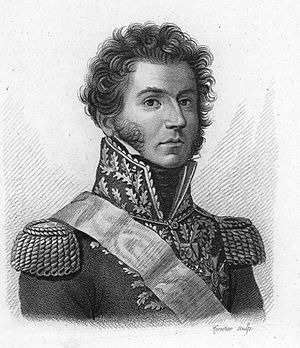Gabriel Jean Joseph Molitor facts for kids
Quick facts for kids
Gabriel Jean Joseph Molitor
|
|
|---|---|

Gabriel Jean Joseph Molitor
|
|
| Born | 7 March 1770 Hayingen, France |
| Died | 28 July 1849 (aged 79) Paris, France |
| Allegiance | |
| Service/ |
Infantry |
| Years of service | 1789–1827 |
| Rank | Maréchal de France |
| Other work | Governor of Les Invalides (1847-1848) |
Gabriel Jean Joseph Molitor (born March 7, 1770, died July 28, 1849) was a very important French military leader. He became a Marshal of France, which is the highest military rank. He lived during a time of big changes in France, including the French Revolution and the rule of Napoleon Bonaparte. Molitor was known for his bravery and skill in many battles across Europe.
Contents
Molitor's Early Military Career
Gabriel Molitor was born in a place called Hayingen in Lorraine, France. When the French Revolution began, he joined the French army. He started as a captain in a group of soldiers called a militia battalion.
Fighting in the Revolution
By 1793, Molitor was put in charge of a larger group of soldiers called a brigade. He served under another famous general named Hoche. Molitor fought in important battles like Kaiserslautern and Wissembourg. In 1795, he was badly hurt during the Battle of Mainz.
Campaigns in Switzerland and Germany
In 1799, Molitor was sent to Switzerland. There, he fought alongside General André Masséna against armies from Austria and Russia. These enemy forces were led by a famous general named Alexander Suvorov. In 1800, Molitor joined the Army of the Rhine and fought under General Moreau.
Serving Under Napoleon
Molitor was promoted to a very high rank, général de division, in 1801. This meant he was in charge of a large group of soldiers.
Battles in Italy and Beyond
In 1805, Molitor went to Italy with General Massena. He took part in battles at places like Vago and Caldiero. The next year, in 1806, he helped to protect the city of Ragusa.
Fighting in Germany and Austria
In 1807, Molitor moved to Germany. He fought against the Swedish army near a city called Stralsund. After these battles, Napoleon made him the governor of Pommern. Napoleon also gave Molitor a special title, making him a Count.
In 1809, Molitor led a division of soldiers in Massena's IV Corps. He fought bravely in two very big battles: Aspern and Wagram.
Later Campaigns and Duties
In 1810, Molitor was sent to take control of cities that belonged to the Hanseatic League. From 1811 to 1813, he served in Holland. In 1814, he fought under General MacDonald during a difficult time for Napoleon.
Life After Napoleon
After Napoleon gave up his power, Molitor accepted the new French kings, known as the Bourbons. They made him an Inspector-General of the infantry, which meant he oversaw all the foot soldiers.
The Hundred Days and Restoration
When Napoleon briefly returned to power in 1815 (a period called the Hundred Days), Molitor joined him. Because of this, he lost his job after Napoleon was finally defeated. However, in 1818, Molitor was allowed to return to his duties.
Becoming a Marshal and Peer
In 1823, Molitor led a group of soldiers called the II Corps to Spain. In the same year, he received the highest military honor: he was made a Marshal of France. He also became a Peer, which meant he was a member of the French Parliament.
Later Years and Legacy
From 1827, Molitor worked as a secretary for the Chamber of Peers. Even after another big change in government, the July Revolution, he kept his important positions. He later became the Governor of Les Invalides, a famous military hospital in Paris. He also served as the Grand Chancellor of the Legion d'Honneur, a very important French award.
Gabriel Molitor passed away in Paris in 1849. Later, a statue was built in his honor in Nancy.
Molitor's Famous Violin
Molitor owned a very special violin called the 1697 Molitor Stradivarius. It was made by the famous violin maker Antonio Stradivari. Some people believed that this violin once belonged to Napoleon Bonaparte himself. In October 2010, the Molitor Stradivarius was sold at an auction for a world record price of $3.6 million.
See also
 In Spanish: Gabriel Jean Joseph Molitor para niños
In Spanish: Gabriel Jean Joseph Molitor para niños

